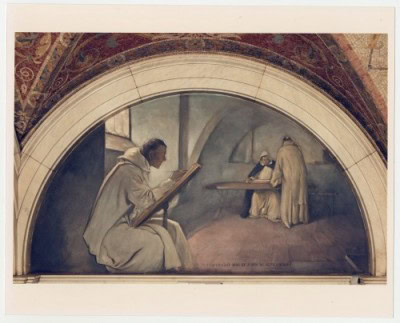Historians often rely on the written record to reconstruct the past. Documents, printed books, and other artifacts all provide historians with the information they need to understand another time period. But what about the records themselves? They, too, have a history, and book historians and textual scholars seek to recover it so that both the objects and their content can be better understood. If you’ve ever spent time poring over a book’s binding, typography, or illustrations while doing archival research, or if you’ve ever wondered how your edition of Franklin’s correspondence was prepared, there are several panels at this year’s annual meeting that you should consider attending.

Mural from the Evolution of the Book series in the Thomas Jefferson Building at the Library of Congress. John W. Alexander, Library of Congress.
On Thursday at 3:30 p.m., check out Documentary Editors Engage the 21st Century. This roundtable brings together four historians who work on digital documentary editions. Tenisha Armstrong (Martin Luther King Jr. Papers), David Coleman (Presidential Recordings Program), Edward Lengel (Washington Papers), and Jennifer Steenshorne (Papers of John Jay) will discuss challenges they face in documentary editing today, as well as opportunities the digital age presents for collaborating with each other, expanding editions’ audiences through social media, and involving students in editing projects.
If you’re interested in getting into the details of digital editing, consider stopping in Marking Text for Digital History: From Microhistory to Big Data with the Text Encoding Initiative (TEI), Sunday at 11:00 a.m. This panel will present a range of projects, both large and small, that use TEI to produce digital editions. The panel aims to demonstrate the versatility of TEI which historians can use to mark themes, show stages of authorship, and record financial information in a text, among other details. Speakers will also consider how encoded texts can be visualized in various ways and help scholars ask new questions about their content. The panel intends to be accessible to those who are completely unfamiliar with TEI, as well as historians who have used it but are interested in hearing about other applications.
For scholars of book history or the history of race and ethnicity, the Society for the History of Authorship, Reading, and Publishing (SHARP) panel will be of particular interest. Panelists in Exploring Race and Ethnicity through Book History, Friday at 2:30 p.m., will use case studies of visual culture, printing, authorship, publishing, and bookselling to demonstrate what book history can reveal about the history of race and ethnicity. For instance, how was race depicted in 19th-century Cairo as textual production shifted from manuscript to print? How do repainted pages of a pre-Columbian Mexican almanac show the sensibilities of the various cultures that used it? How did visual culture affect abolitionists’ views of African Americans? And how could book marketing and distribution become a way of promoting African American race identity in 20th-century America? As panelists consider these specific questions, the overall goal of the panel will be to teach the audience about book history and help them understand how they can use it in their own work. SHARP has also organized a tour of the Robert W. Woodruff Library, Thursday at 3:30 p.m., which will highlight materials related to race and ethnicity in book history.
Aside from these sessions, there are several poster presentations and panels that include papers focusing on textual studies or book history. These are methods that can be applied widely—to any time period or geography where humans produced written records, in fact—so consider stopping by and learning about these exciting fields.
Other Book History and Textual Presentations
Panel: From Missionization to Indigenization: Seventh-Day Adventists and Religious Print in China
Panel: “Global” and Entangled Histories of Early Modernity Part 1
Panel: Textual Communities and Religious Networks in 18th-Century British America
Paper: Textual Marginalia in the East European Reformation: An Unknown Book from Szymon Budny’s Library
Paper: Global Early Modernity and Mobility: Port Cities and Printers in the Armenian Diaspora, 1512–1800
Paper: Graphic Battles: Contests over History and Politics in Non-state Comic Books, 1970–2000
Paper: Identity Papers and Paper Nations: Making Nationality at Sea in the Revolutionary Era
Poster: Gutenberg’s Children: Making Print in 19th-Century Mexico City
Poster: Growing up in Peronist Argentina, 1946–55: The Lived Experiences of Children through State Ephemera
This post first appeared on AHA Today.
This work is licensed under a Creative Commons Attribution-NonCommercial-NoDerivatives 4.0 International License. Attribution must provide author name, article title, Perspectives on History, date of publication, and a link to this page. This license applies only to the article, not to text or images used here by permission.